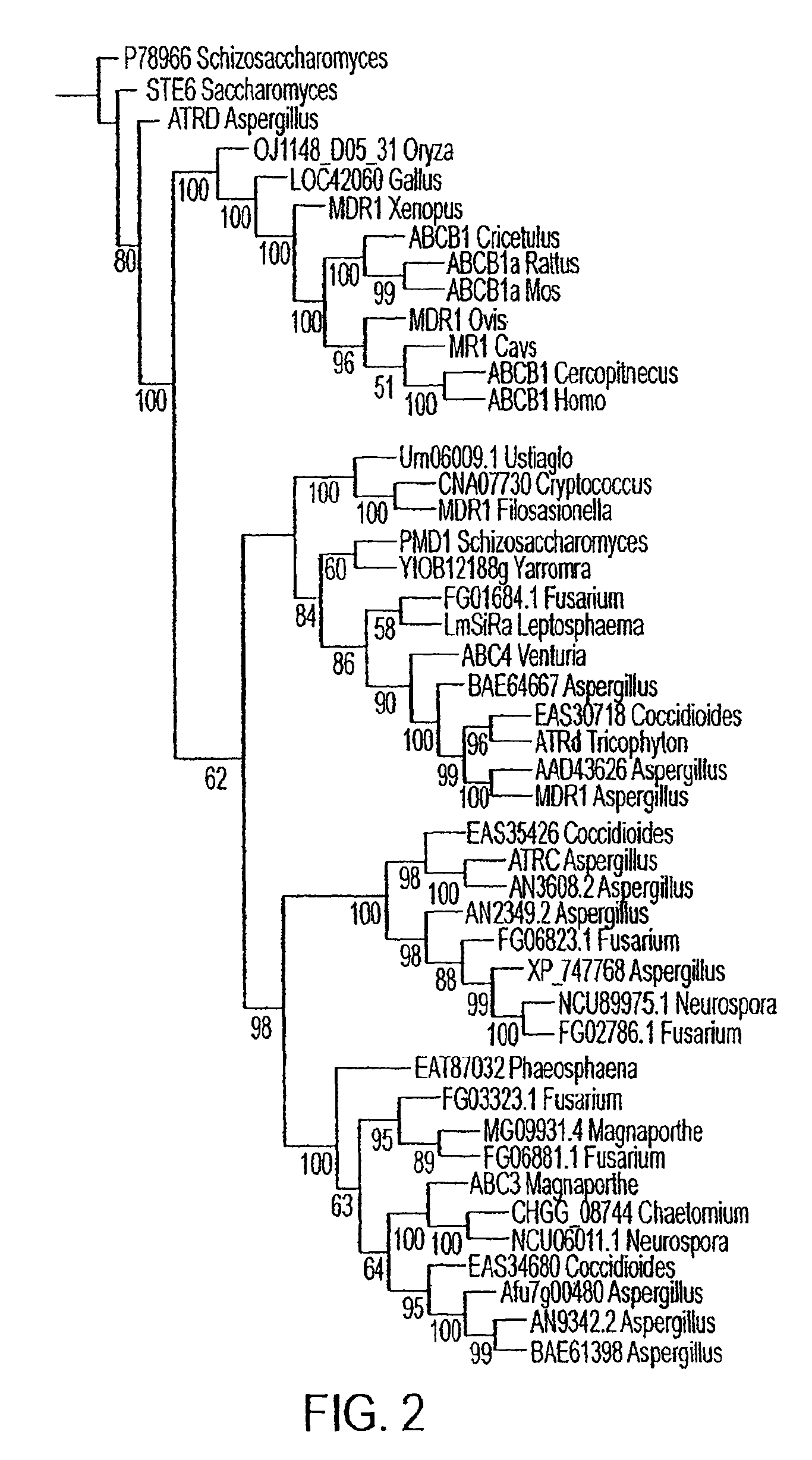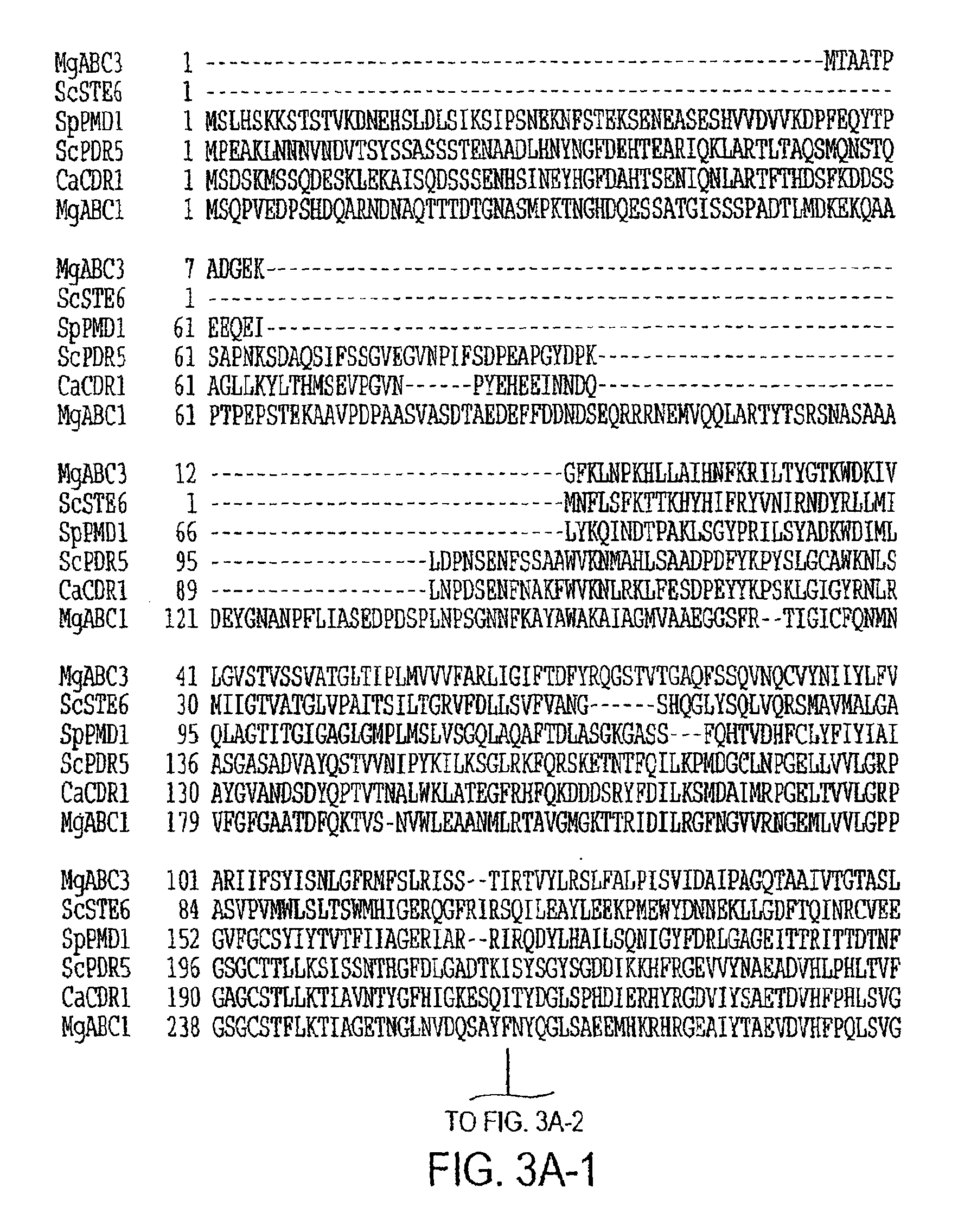System for inhibiting pathogenicity in the rice-blast fungus Magnaporthe grisea
a technology of pathogenicity and rice, applied in the field of molecular biology and plant fungal diseases, can solve the problems of significant crop loss annually, inability to control the growth rate of riceblast fungus magnaporthe grisea,
- Summary
- Abstract
- Description
- Claims
- Application Information
AI Technical Summary
Benefits of technology
Problems solved by technology
Method used
Image
Examples
example 1
Identification and Isolation of the ABC3 Locus
[0085]Schizosaccharomyces pombe wild-type strain YNB38 (h-, ade6-M216 / leu1-32 / ura4-D18 / his3-D1) was maintained on yeast-extract plus supplements (YES) agar medium or under selection on Edinburgh minimal media (EMM), with appropriate supplements, using standard techniques as described in Moreno et al., “Molecular genetic analysis of fission yeast Schizosaccharomyces pombe” Meth. Enzymol., 194:795-823, 1991. Strains were grown on agar plates or in liquid media at 32° C.
[0086]Wild-type strains of M. grisea, Guy11 (mat1-2) and TH3 (mat1-1), were used in the following methods. Guy11, and the abc3Δ knockout and complementation strains were cultured on prune-agar medium or complete medium (CM) as described by Soundararajan et al., “Woronin body function in Magnaporthe grisea is essential for efficient pathogenesis and for survival during nitrogen starvation stress” Plant Cell, 16:1564-1574, 2004. Mycelia, collected from 2-day-old liquid CM-grow...
example 2
Deletion of the ABC3 Open Reading Frame
[0106]One-step PCR-based gene deletion (using the Ura4+ marker) was performed according to the methods of Bahler et al., “Heterologous modules for efficient and versatile PCR-based gene targeting in Schizosaccharomyces pombe” Yeast 14:943-951, 1998, using 80 bp flanking sequence homology. Deletion of the pmd1 open reading frame was carried out in the YNB38 strain. Stable transformants from EMM minus Uracil medium were tested by colony PCR. The M. grisea abc3 locus was obtained as a 6.3 Kb HinDIII fragment from BAC 22C21 and cloned into the unique HinDIII site in pJK148 to obtain pFGLr1, carrying the Leu1+ marker. Vector pFGLr1 was linearized with EcoRI and transformed by electroporation into the S. pombe pmd1 deletion strain described above. Stable integration of FGLr1 was confirmed by PCR analysis and copy number ascertained by Southern blot analysis.
[0107]Using plasmid vector pFGLabcKO in a one-step gene replacement technique, an abc3 deletio...
example 3
Phenotypic Characterization of abc3Δ Strains
[0108]pFGLr2 (carrying the full-length abc3 gene) or pBarKS (control) was introduced into the abc3Δ strain and the TMT2807 mutant. About 20 bialaphos-resistant transformants were screened by DNA gel blot analysis in each instance. Two strains that carried single-copy integration of the abc3 gene at an ectopic site in each background (TMT2807 and abc3Δ) were used for further tests.
[0109]For abc3 gene deletion and rescue of the abc3Δ mutant, DNA fragments about 1.1 kb each, representing the 5′ and 3′ UTR of abc3 gene, were obtained by PCR. The fragments were ligated sequentially so as to flank the hph cassette in pFGL44 to obtain plasmid vector pFGLabcKO. pFGLabcKO was transformed into M. grisea for replacement of the abc3 gene. The complete M. grisea abc3 locus was obtained as a 6.2 Kb HinDIII fragment from the BAC 22C21 and cloned into the HinDIII site of pFGL97 to obtain pFGLr2 with resistance to bialaphos or ammonium gluphosinate as a fu...
PUM
| Property | Measurement | Unit |
|---|---|---|
| molar concentrations | aaaaa | aaaaa |
| concentration | aaaaa | aaaaa |
| time | aaaaa | aaaaa |
Abstract
Description
Claims
Application Information
 Login to View More
Login to View More - R&D
- Intellectual Property
- Life Sciences
- Materials
- Tech Scout
- Unparalleled Data Quality
- Higher Quality Content
- 60% Fewer Hallucinations
Browse by: Latest US Patents, China's latest patents, Technical Efficacy Thesaurus, Application Domain, Technology Topic, Popular Technical Reports.
© 2025 PatSnap. All rights reserved.Legal|Privacy policy|Modern Slavery Act Transparency Statement|Sitemap|About US| Contact US: help@patsnap.com



